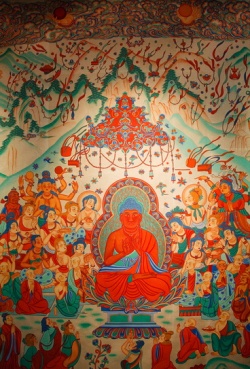Sukhavati
Sukhavati (Skt. Sukhāvatī; Tib. བདེ་བ་ཅན་, Dewachen; Wyl. bde ba can or bde ba chen) is the blissful Buddha field of Amitabha. One of The Buddha fields of the five families, said to be located in the western direction
Sukhavati, ( Sanskrit: “Pure land”) in the Pure land schools of Mahayana Buddhism, The Western Paradise of The Buddha Amitabha, described in the Pure land Sutras (Sukhavati-vyuha-Sutras). According to followers of the Pure land schools, which are widespread throughout East Asia, Rebirth in Sukhavati is ensured by invoking the name of Amitabha, particularly at the moment of Death. According to Doctrine, only men may be reborn in Sukhavati; however, some vernacular Buddhist writings demonstrate a popular belief that women may also enter Sukhavati upon Death. Sukhavati is expressively described in the Pure land Sutras as being a joyous World, soft and glowing, filled with the music of birds and the tinkling of trees adorned with precious jewels and garlands of golden bells. Amitabha sits on a Lotus in the midst of a terraced pond, attended by the Bodhisattvas (“Buddhas-to-be”) Avalokiteshvara and Mahasthamaprapta. The newly dead enter into Lotus buds, which unfold when the occupants have become entirely purified and have attained Enlightenment. Many are said to be reborn on Earth after leaving Sukhavati to become boddhisattvas working toward the Liberation (moksha) of all Sentient beings.
Four Causes of Rebirth in Sukhavati
According to Jamgön Ngawang Lekpa, the four causes of Rebirth in Sukhavati are:
Generating Bodhichitta
Accumulating Merit in many ways
Repeatedly bringing The Buddha field to Mind
Dedicating all one's sources of Merit as causes for Rebirth in that pure realm
Lala Sonam Chödrup, in his famous commentary on the Prayer of Sukhavati (Tib. Démön; Wyl. bde smon), gives them as:
the support, visualizing the pure realm
accumulating Merit and purifying obscurations
the aid, generating Bodhichitta
the circumstance, pure prayers of aspiration, dedicating all sources of Virtue so that oneself and others may be reborn in Sukhavati
The Smaller Sukhavativyuha Sutra (Skt. Sukhāvatīvyūhasūtra), which takes place in the Jeta Grove, contains a description of the Sukhavati pure realm of Buddha Amitabha. It was translated into Tibetan from Sanskrit by Shyang Yeshé Dé.
